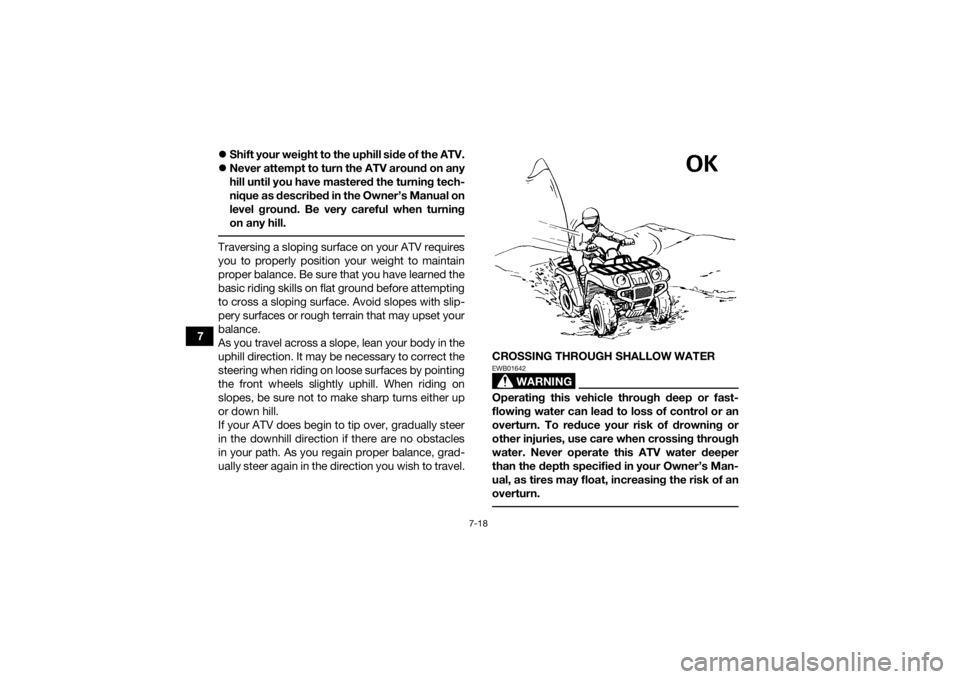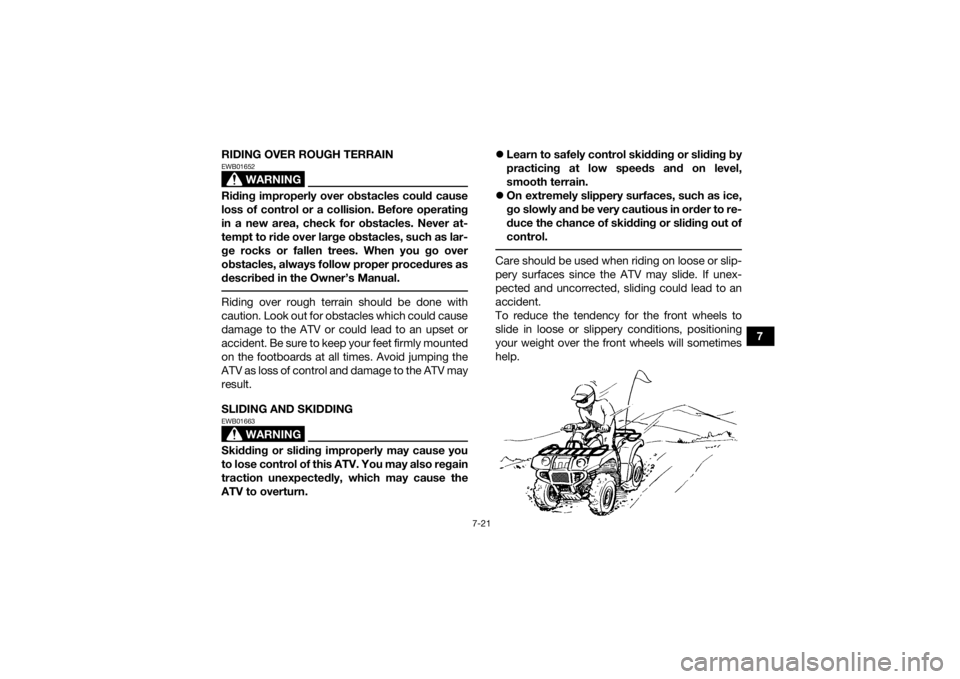Page 78 of 146

7-18
7
Shift your weight to the uphill side of the ATV.
Never attempt to turn the ATV around on any
hill until you have mastered the turning tech-
nique as described in the Owner’s Manual on
level ground. Be very careful when turning
on any hill.
Traversing a sloping surface on your ATV requires
you to properly position your weight to maintain
proper balance. Be sure that you have learned the
basic riding skills on flat ground before attempting
to cross a sloping surface. Avoid slopes with slip-
pery surfaces or rough terrain that may upset your
balance.
As you travel across a slope, lean your body in the
uphill direction. It may be necessary to correct the
steering when riding on loose surfaces by pointing
the front wheels slightly uphill. When riding on
slopes, be sure not to make sharp turns either up
or down hill.
If your ATV does begin to tip over, gradually steer
in the downhill direction if there are no obstacles
in your path. As you regain proper balance, grad-
ually steer again in the direction you wish to travel. CROSSING THROUGH SHALLOW WATER
WARNING
EWB01642Operating this vehicle through deep or fast-
flowing water can lead to loss of control or an
overturn. To reduce your risk of drowning or
other injuries, use care when crossing through
water. Never operate this ATV water deeper
than the depth specified in your Owner’s Man-
ual, as tires may float, increasing the risk of an
overturn.
U1NS64E0.book Page 18 Thursday, June 25, 2015 8:36 AM
Page 81 of 146

7-21
7
RIDING OVER ROUGH TERRAIN
WARNING
EWB01652Riding improperly over obstacles could cause
loss of control or a collision. Before operating
in a new area, check for obstacles. Never at-
tempt to ride over large obstacles, such as lar-
ge rocks or fallen trees. When you go over
obstacles, always follow proper procedures as
described in the Owner’s Manual. Riding over rough terrain should be done with
caution. Look out for obstacles which could cause
damage to the ATV or could lead to an upset or
accident. Be sure to keep your feet firmly mounted
on the footboards at all times. Avoid jumping the
ATV as loss of control and damage to the ATV may
result.
SLIDING AND SKIDDING
WARNING
EWB01663Skidding or sliding improperly may cause you
to lose control of this ATV. You may also regain
traction unexpectedly, which may cause the
ATV to overturn.
Learn to safely control skidding or sliding by
practicing at low speeds and on level,
smooth terrain.
On extremely slippery surfaces, such as ice,
go slowly and be very cautious in order to re-
duce the chance of skidding or sliding out of
control.
Care should be used when riding on loose or slip-
pery surfaces since the ATV may slide. If unex-
pected and uncorrected, sliding could lead to an
accident.
To reduce the tendency for the front wheels to
slide in loose or slippery conditions, positioning
your weight over the front wheels will sometimes
help.
U1NS64E0.book Page 21 Thursday, June 25, 2015 8:36 AM
Page 82 of 146

7-22
7If the rear wheels of your ATV start to slide side-
ways, control can usually be regained (if there is
room to do so) by steering in the direction of the
slide. Applying the brakes or accelerating is not
recommended until you have corrected the slide.
With practice, over a period of time, skill at con-
trolled sliding can be developed. The terrain
should be chosen carefully before attempting
such maneuvers, since both stability and control
are reduced. Bear in mind that sliding maneuvers
should always be avoided on extremely slippery
surfaces such as ice, since all control may be lost. WHAT TO DO IF...
This section is designed to be a reference guide
only. Be sure to read each section on riding tech-
niques completely.
WHAT TO DO...
If your ATV doesn’t turn when you want it to:
Bring the ATV to a stop and practice the turning
maneuvers again. Be sure you are putting your
weight on the footboard to the outside of the
turn. Position your weight over the front wheels
for better control. (See page 7-12.)
If your ATV begins to tip while turning:
Lean more into the turn to regain balance. If
necessary, gradually let off the throttle and/or
steer to the outside of the turn. (See page 7-12.)
If your ATV starts to slide sideways:
Steer in the direction of the slide if you have the
room. Applying the brakes or accelerating is not
recommended until you have corrected the
slide. (See page 7-21.)
If your ATV can’t make it up a hill you are trying
to climb:
Turn the ATV around if you still have forward
speed. If not, stop, dismount on the uphill side
of the ATV and physically turn the ATV around.
If the ATV starts to slip backwards, DO NOT
U1NS64E0.book Page 22 Thursday, June 25, 2015 8:36 AM
Page 89 of 146

8-6
8
4*Brake hoses • Check for cracks or other damage, and replace if
necessary. √√√√
• Replace. Every 4 years
5 *Brake fluid • Change. Every 2 years
6 *Wheels • Check runout and for damage, and replace if nec-
essary. √ √√√
7 *Tires • Check tread depth and for damage, and replace if
necessary.
• Check air pressure and balance, and correct if necessary. √ √√√
8 *Wheel hub bearings • Check for looseness or damage, and replace if
necessary. √ √√√
9 *Swingarm • Check for excessive play, and correct if neces-
sary. √√√
10 *V- b e l t • Check for wear, cracks or other damage, and re-
place if necessary. √ √√√
11 *Chassis fasteners • Make sure that all nuts, bolts, and screws are
properly tightened. √√√√√
12 *Shock absorber as-
semblies • Check operation and correct if necessary.
• Check for oil leakage and replace if necessary.
√√√
13 *Steering shaft • Lubricate with lithium-soap-based grease. √√√
NO. ITEM
CHECK OR MAINTENANCE
JOB INITIAL EVERY
Whichev- er comes first month136612
km (mi) 320
(200) 1300
(800) 2500
(1600) 2500
(1600) 5000
(3200)
hours 20 80 160 160 320
U1NS64E0.book Page 6 Thursday, June 25, 2015 8:36 AM
Page 111 of 146
8-28
8
EBU24121Checking the front brake pads and rear
brake shoesThe front brake pads and the rear brake shoes
must be checked for wear at the intervals speci-
fied in the periodic maintenance and lubrication
chart.EBU24172Front brake pads
Check each front brake pad for damage and mea-
sure the lining thickness. If a brake pad is dam-
aged or if the lining thickness is less than 1.0 mm
(0.04 in), have a Yamaha dealer replace the brake
pads as a set.
TIPThe wheels need to be removed to check the
brake pads. (See page 8-46.) EBU24181Rear brake shoes
The rear brake is provided with a wear indicator,
which allows you to check the brake shoe wear
without having to disassemble the brake. To
check the brake shoe wear, check the position of
the wear indicator while applying the brake. If a1. Brake pad
2. Lining thickness
2
1
U1NS64E0.book Page 28 Thursday, June 25, 2015 8:36 AM
Page 116 of 146
8-33
8Adjusting the brake pedal free play
The brake pedal free play should measure 20.0–
30.0 mm (0.79–1.18 in) as shown. If the free play is
incorrect, adjust it as follows. 1. Fully loosen the brake lever free play adjust-
ing nut on the brake cable at the rear wheel
hub.
2. Turn the brake pedal free play adjusting nut on the brake cable at the rear wheel hub in di-
rection (a) to increase the free play, and in di-
rection (b) to decrease it.
1. Footboard bolt A
2. Footboard bolt BTightening torques:Footboard bolt A:3.0 Nm (0.30 m·kgf, 2.2 ft·lbf)
Footboard bolt B: 7 Nm (0.7 m·kgf, 5.1 ft·lbf)11
2
1. Brake pedal free play
U1NS64E0.book Page 33 Thursday, June 25, 2015 8:36 AM
Page 117 of 146
8-34
8
Adjusting the brake lever free play
The brake lever free play should measure 3.0–5.0
mm (0.12–0.20 in) as shown. If the free play is in-
correct, adjust it as follows. 1. Loosen the locknut at the brake lever and fully
turn in the brake lever free play adjusting bolt.
2. Turn the brake lever free play adjusting nut on the brake cable at the rear wheel hub so that
gap “A” measures 0–1 mm (0–0.04 in).
1. Brake pedal free play adjusting nut
2. Brake lever free play adjusting nut
1. Brake lever free play
2. Locknut
3. Brake lever free play adjusting bolt
U1NS64E0.book Page 34 Thursday, June 25, 2015 8:36 AM
Page 121 of 146
8-38
8
Rear brake lever
EBU28872Checking and lubricating the brake
pedalThe operation of the brake pedal should be
checked before each ride, and the pedal pivot
should be lubricated if necessary.
EBU24964Checking the wheel hub bearingsThe front and rear wheel hub bearings must be
checked at the intervals specified in the periodic
maintenance and lubrication chart. If there is play
in a wheel hub or if a wheel does not turn smooth-
ly, have a Yamaha dealer check the wheel hub
bearings.
Recommended lubricant:
Lithium-soap-based grease
U1NS64E0.book Page 38 Thursday, June 25, 2015 8:36 AM